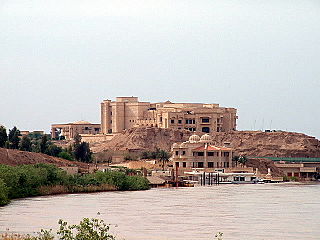
Tikrit is a city in Iraq, located 140 kilometres (87 mi) northwest of Baghdad and 220 kilometres (140 mi) southeast of Mosul on the Tigris River. It is the administrative center of the Saladin Governorate. As of 2012, it had a population of approximately 160,000.
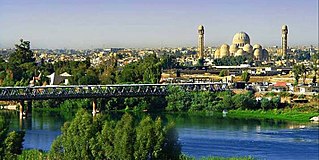
Mosul is a major city in northern Iraq, serving as the capital of Nineveh Governorate. The city is considered the second largest city in Iraq in terms of population and area after the capital Baghdad, with a population of over 3.7 million. Mosul is approximately 400 km (250 mi) north of Baghdad on the Tigris river. The Mosul metropolitan area has grown from the old city on the western side to encompass substantial areas on both the "Left Bank" and the "Right Bank", as locals call the two riverbanks. Mosul encloses the ruins of the ancient Assyrian city of Nineveh on its east side.
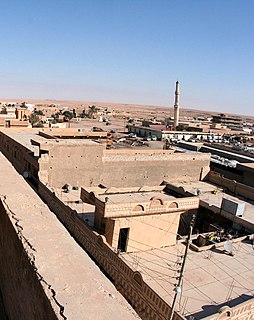
Ar-Rutbah is an Iraqi town in western Al Anbar province, completely inhabited with Sunni Muslims. The population is approximately 28,400. It occupies a strategic location on the Amman–Baghdad road, and the Kirkuk–Haifa oil pipeline. Considered a "wet spot", it receives 114.3 mm (4.5 inches) of rain annually, and is located on a high plateau. It has been described as "the most isolated town of any size in Iraq."

Majid al Tamimi Airbase, officially known as the Tikrit Air Academy and formerly as FOB Speicher, COB Speicher, and Al Sahra Airfield is an air installation near Tikrit in northern Iraq. The installation is approximately 170 kilometers north of Baghdad and 11 kilometers west of the Tigris River. Prior to 2003, Al Sahra Airfield was the main base of the Iraqi Air Force Air Academy. The Marines from Task Force Tripoli captured the base from the Iraqi Army during the 2003 U.S. invasion of Iraq and turned it over the United States Army who used it as the headquarters of the United States Division–North. The airfield is served by two main runways measuring 9,600 feet (2,900 m) long with a shorter runway measuring 7,200-foot (2,200 m). The Americans named the airfield after Captain Michael Scott Speicher, a United States Navy pilot who was killed in action in Iraq during the 1991 Gulf War.
Qayyarah Airfield West is an Iraqi Air Force base in the Qayyarah subdistrict of Mosul District in northern Iraq. It was captured by U.S. Army during Operation Iraqi Freedom in 2003. It was also known as Q–West or Key West by the various U.S. Army Forces and civilian contractors stationed there. Control of the base was returned to Iraq in March 2020.
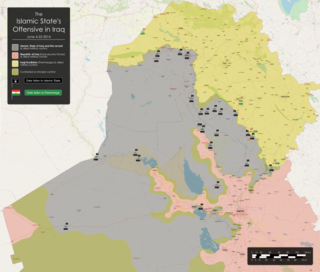
The 2014 Islamic State invasion of Iraq began on 4 June 2014, when the Islamic State began a major offensive from its territory in Syria into Iraq against Iraqi and Kurdish forces, following earlier clashes that had begun in December 2013 involving guerillas.

The First Battle of Tikrit was a battle for the Iraqi city of Tikrit following the city's capture by the Islamic State and Ba'athist Loyalists during the 2014 Northern Iraq offensive. The battle took place between 26 and 30 June 2014.
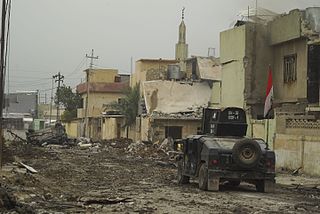
The War in Iraq was an armed conflict between Iraq and its allies and the Islamic State which began in 2013 and ended in December 2017. Following December 2013, the insurgency escalated into full-scale guerrilla warfare following clashes in the cities of Ramadi and Fallujah in parts of western Iraq, and culminated in the 2014 Islamic State invasion of Iraq in June 2014, which lead to the capture of the cities of Mosul, Tikrit and other cities in western and northern Iraq by the Islamic State. Between 4–9 June 2014, the city of Mosul was attacked and later fell, following that, former Prime Minister Nuri al-Maliki called for a national state of emergency on 10 June. However, despite the security crisis, Iraq's parliament did not allow Maliki to declare a state of emergency; many legislators boycotted the session because they opposed expanding the prime minister's powers. Ali Ghaidan, a former military commander in Mosul, accused al-Maliki of being the one who issued the order to withdraw from the city of Mosul. At its height, ISIL held 56,000 square kilometers of Iraqi territory, containing 4.5 million citizens.
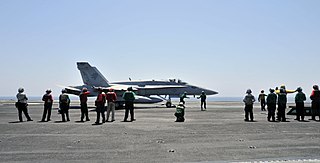
On 15 June 2014, U.S. President Barack Obama ordered United States forces to be dispatched in response to the Northern Iraq offensive of the Islamic State of Iraq and the Levant (ISIL) as part of Operation Inherent Resolve. At the invitation of the Iraqi government, American troops went to assess Iraqi forces and the threat posed by ISIL.

The Battle of Baiji was a battle that took place in Baiji, Iraq, lasting from late October 2014 to late October 2015. In mid-November 2014, Iraqi forces retook the city of Baiji, and re-entered the Baiji Oil Refinery. However, fighting continued in the region, and on 21 December 2014, ISIL forces took Baiji and put the Baiji oil refinery under siege once again, before Iraqi forces recaptured the city on October 22. It gave Iraqi forces complete control of the highway stretching from Baghdad to Baiji, and allowed Iraqi forces to use Baiji as a base for launching a future assault on Mosul.

The Sinjar offensive was a combination of operations of Kurdish Peshmerga, PKK and People's Protection Units forces in December 2014, to recapture regions formerly lost to the Islamic State of Iraq and the Levant in their August offensive.
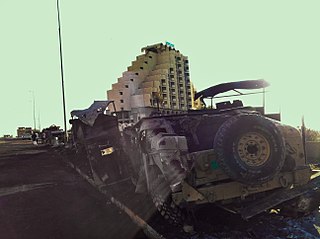
The Fall of Mosul occurred between 4–10 June 2014, when Islamic State insurgents, initially led by Abu Abdulrahman al-Bilawi, captured Mosul from the Iraqi Army, led by Lieutenant General Mahdi Al-Gharrawi.

The Second Battle of Tikrit was a battle in which Iraqi Security Forces recaptured the city of Tikrit from the Islamic State of Iraq and the Levant (ISIL). Iraqi forces consisted of the Iraqi Army and the Popular Mobilization Forces, receiving assistance from Iran's Quds Force officers on the ground, and air support from the American, British, and French air forces.

The Mosul offensive (2015) was an offensive launched by Kurdish Peshmerga forces on 21 January 2015, with the objective of severing key ISIL supply routes to Mosul, Iraq, and to recapture neighboring areas around Mosul. The effort was supported by US-led coalition airstrikes. The Iraqi Army was widely expected to launch the planned operation to retake the actual city of Mosul in the Spring of 2015, but the offensive was postponed to October 2016, after Ramadi fell to ISIL in May 2015.
In early 2014, the jihadist group Islamic State of Iraq and the Levant captured extensive territory in Western Iraq in the Anbar campaign, while counter-offensives against it were mounted in Syria. Raqqa in Syria became its headquarters. The Wall Street Journal estimated that eight million people lived under its control in the two countries.
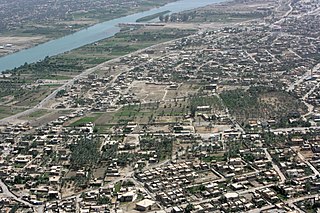
The Battle of Ramadi was a battle launched by the forces of Iraq to successfully recapture the city of Ramadi from the Islamic State of Iraq and the Levant (ISIL), which had taken the city earlier in 2015 in a previous battle. Air power was a major component of the battle, with the United States and other nations conducting over 850 airstrikes in the Ramadi area from July 2015 to late February 2016, and the US crediting airstrikes with 80% of the reason why the city was recaptured. By February 2016, Iraqi forces successfully recaptured the city after two and a half months of fighting. It was predicted that it would take several months to clear the city of the bombs ISIL left behind, with at least 9 months needed to clear the city's Tamim District. At the time, Ramadi had suffered more damage than any other city or town in Iraq.

The Shirqat offensive, codenamed Operation Conquest or Operation Fatah, was an offensive against the positions of the Islamic State of Iraq and the Levant (ISIL) in and around the district of Al-Shirqat District to reach the city of Mosul.

The Battle of Mosul was a major military campaign launched by the Iraqi Government forces with allied militias, the Kurdistan Regional Government, and international forces to retake the city of Mosul from the Islamic State (ISIL), which had seized the city in June 2014. The battle was the world's single largest military operation since the 2003 invasion of Iraq and was considered the toughest urban battle since World War II.
The 2017 Western Nineveh offensive, code-named Operation Muhammad, Prophet of God, was launched by the Iraqi Popular Mobilization Forces (PMF) against the Islamic State of Iraq and the Levant (ISIL) in the western Nineveh province of northern Iraq in late April 2017.
The Western Anbar offensive (2017) was a military operation by the Iraqi Army against the Islamic State of Iraq and the Levant, in the western districts of the Province of Anbar and on the border with Syria.
















